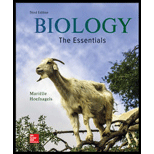
Biology
3rd Edition
ISBN: 9781259824913
Author: Hoefnagels, Mariëlle
Publisher: Mcgraw-hill Education,
expand_more
expand_more
format_list_bulleted
Question
Chapter 29.1, Problem 2MC
Summary Introduction
To determine:
The way in which immune system interacts with the circulatory system of the body.
Introduction:
There are many pathogenic organisms that attack other organisms and cause infectious diseases. These organisms are termed as pathogens. Microbes are the most dangerous pathogens that attack the human body. However, all organisms have a well-defined organ system that fights with these pathogens and protect the body from infectious diseases. This organ system is called the immune system.
Expert Solution & Answer
Want to see the full answer?
Check out a sample textbook solution
Students have asked these similar questions
When beta-lactamase was isolated from Staphylcoccus aureus and treated with a phosphorylating agent, only the active site, serine was phosphorylated. Additionally, the serine was found to constitute 0.35% (by weight) of this beta-lactamase enzyme. Using this, calculate the molecular weight of this enzyme and estimate the number of amino acids present in the polypeptide.
Based on your results from the Mannitol Salt Agar (MSA) media, which of your bacteria were mannitol fermenters and which were not mannitol fermenters?
help tutor please
Chapter 29 Solutions
Biology
Ch. 29.1 - List the cell types that participate in the bodys...Ch. 29.1 - Prob. 2MCCh. 29.1 - Prob. 3MCCh. 29.1 - Prob. 4MCCh. 29.2 - Prob. 1MCCh. 29.2 - Describe the external barriers to infection.Ch. 29.2 - Prob. 3MCCh. 29.2 - Prob. 4MCCh. 29.2 - Prob. 5MCCh. 29.3 - Prob. 1MC
Ch. 29.3 - Prob. 2MCCh. 29.3 - Prob. 3MCCh. 29.3 - Prob. 4MCCh. 29.3 - Prob. 5MCCh. 29.4 - What is a vaccine?Ch. 29.4 - Prob. 2MCCh. 29.4 - Prob. 3MCCh. 29.5 - Prob. 1MCCh. 29.5 - Prob. 2MCCh. 29.5 - Prob. 3MCCh. 29 - Prob. 1MCQCh. 29 - Prob. 2MCQCh. 29 - Prob. 3MCQCh. 29 - Prob. 4MCQCh. 29 - Prob. 5MCQCh. 29 - Prob. 6MCQCh. 29 - During the humoral immune response, a. B cells...Ch. 29 - Prob. 8MCQCh. 29 - How do vaccines prevent infectious disease? a. By...Ch. 29 - Prob. 10MCQCh. 29 - Prob. 1WIOCh. 29 - Explain why a scraped knee increases the chance...Ch. 29 - Prob. 3WIOCh. 29 - Prob. 4WIOCh. 29 - Prob. 5WIOCh. 29 - Briefly explain the function of each innate and...Ch. 29 - What do a plasma cell and a memory cell descended...Ch. 29 - Prob. 8WIOCh. 29 - Prob. 9WIOCh. 29 - Prob. 10WIOCh. 29 - Prob. 11WIOCh. 29 - Prob. 12WIOCh. 29 - Prob. 13WIOCh. 29 - Prob. 14WIOCh. 29 - Prob. 1SLCh. 29 - Review the survey the Landscape figure in the...Ch. 29 - Add memory B cells, plasma cells, memory cytotoxic...Ch. 29 - Prob. 3PITCh. 29 - Prob. 4PIT
Knowledge Booster
Similar questions
- Q8. A researcher wants to study the effectiveness of a pill intended to reduce stomach heartburn in pregnant women. The researcher chooses randomly 400 women to participate in this experiment for 9 months of their pregnancy period. They all need to have the same diet. The researcher designs two groups of 200 participants: One group take the real medication intended to reduce heartburn, while the other group take placebo medication. In this study what are: Independent variable: Dependent variable: Control variable: Experimental group: " Control group: If the participants do not know who is consuming the real pills and who is consuming the sugar pills. This study is It happens that 40% of the participants do not find the treatment helpful and drop out after 6 months. The researcher throws out the data from subjects that drop out. What type of bias is there in this study? If the company who makes the medication funds this research, what type of bias might exist in this research work?arrow_forwardHow do I determine the inhertiance pattern from the pedigree diagram?arrow_forwardits an open book assignemntarrow_forward
- Describe two different gene regulation mechanisms involving methylationarrow_forwardWhat is behavioral adaptarrow_forward22. Which of the following mutant proteins is expected to have a dominant negative effect when over- expressed in normal cells? a. mutant PI3-kinase that lacks the SH2 domain but retains the kinase function b. mutant Grb2 protein that cannot bind to RTK c. mutant RTK that lacks the extracellular domain d. mutant PDK that has the PH domain but lost the kinase function e. all of the abovearrow_forward
arrow_back_ios
SEE MORE QUESTIONS
arrow_forward_ios
Recommended textbooks for you
 Concepts of BiologyBiologyISBN:9781938168116Author:Samantha Fowler, Rebecca Roush, James WisePublisher:OpenStax College
Concepts of BiologyBiologyISBN:9781938168116Author:Samantha Fowler, Rebecca Roush, James WisePublisher:OpenStax College Biology 2eBiologyISBN:9781947172517Author:Matthew Douglas, Jung Choi, Mary Ann ClarkPublisher:OpenStax
Biology 2eBiologyISBN:9781947172517Author:Matthew Douglas, Jung Choi, Mary Ann ClarkPublisher:OpenStax Human Physiology: From Cells to Systems (MindTap ...BiologyISBN:9781285866932Author:Lauralee SherwoodPublisher:Cengage Learning
Human Physiology: From Cells to Systems (MindTap ...BiologyISBN:9781285866932Author:Lauralee SherwoodPublisher:Cengage Learning Anatomy & PhysiologyBiologyISBN:9781938168130Author:Kelly A. Young, James A. Wise, Peter DeSaix, Dean H. Kruse, Brandon Poe, Eddie Johnson, Jody E. Johnson, Oksana Korol, J. Gordon Betts, Mark WomblePublisher:OpenStax College
Anatomy & PhysiologyBiologyISBN:9781938168130Author:Kelly A. Young, James A. Wise, Peter DeSaix, Dean H. Kruse, Brandon Poe, Eddie Johnson, Jody E. Johnson, Oksana Korol, J. Gordon Betts, Mark WomblePublisher:OpenStax College

Concepts of Biology
Biology
ISBN:9781938168116
Author:Samantha Fowler, Rebecca Roush, James Wise
Publisher:OpenStax College


Biology 2e
Biology
ISBN:9781947172517
Author:Matthew Douglas, Jung Choi, Mary Ann Clark
Publisher:OpenStax

Human Physiology: From Cells to Systems (MindTap ...
Biology
ISBN:9781285866932
Author:Lauralee Sherwood
Publisher:Cengage Learning

Anatomy & Physiology
Biology
ISBN:9781938168130
Author:Kelly A. Young, James A. Wise, Peter DeSaix, Dean H. Kruse, Brandon Poe, Eddie Johnson, Jody E. Johnson, Oksana Korol, J. Gordon Betts, Mark Womble
Publisher:OpenStax College
